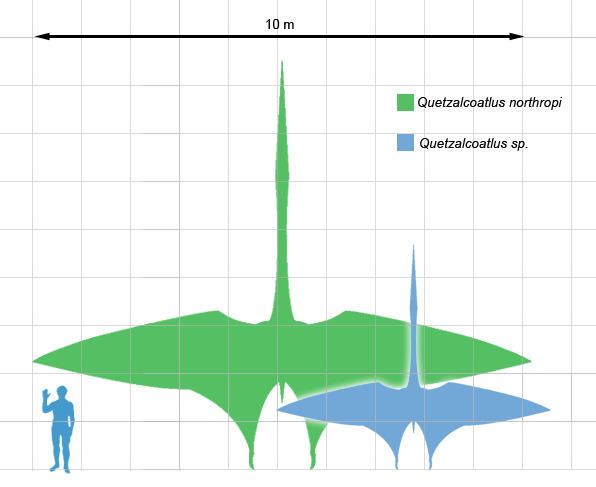 | ||
Pterosaurs included the largest flying animals ever to have lived. They are a clade of prehistoric archosaurian reptiles closely related to dinosaurs. Species among pterosaurs occupied several types of environments, which ranged from aquatic to forested. Below is a list that comprises the largest pterosaurs known as of 2016.
Contents
The smallest known pterosaur is Nemicolopterus with a wingspan of about 250 mm (10 in). The specimen found may be a juvenile or a subadult, and adults may have been larger.
Pterosaurs with largest wingspan
This is a list of pterosaurs with estimated maximum wingspan of more than 5 metres (16 feet):
- Arambourgiania philadelphiae 7–13 m (23–43 ft)
- Hatzegopteryx thambema 10–11 m (33–36 ft)
- Quetzalcoatlus northropi 10–11 m (33–36 ft)
- Tropeognathus mesembrinus 8.2 m (27 ft)
- Geosternbergia maysei 7.25 m (24 ft)
- Coloborhynchus capito 7 m (23 ft)
- Moganopterus zhuiana 7 m (23 ft)
- Pteranodon longiceps 6.25 m (20.5 ft)
- Tupuxuara longicristatus 6 m (20 ft)
- Santanadactylus araripensis 5.7 m (19 ft)
- Cearadactylus atrox 5.5 m (18 ft)
- Caulkicephalus trimicrodon 5 m (16 ft)
- Istiodactylus latidens 5 m (16 ft)
- Lacusovagus magnificens 5 m (16 ft)
- Liaoningopterus gui 5 m (16 ft)
- Phosphatodraco mauritanicus 5 m (16 ft)
Speculation about pterosaur size and flight
Some species of pterosaurs grew to very large sizes and this has implications for their capacity for flight. Many pterosaurs were small but the largest had wingspans which exceeded 9 m (30 ft). The largest of these are estimated to have weighed 250 kilograms (550 lb). For comparison, the wandering albatross has the largest wingspan of living birds at up to 3.5 m (11 ft) but usually weighs less than 12 kilograms (26 lb). This indicates that the largest pterosaurs may have had higher wing loadings than modern birds (depending on wing profile) and this has implications for the manner in which pterosaur flight might differ from that of modern birds.
Factors such as the warmer climate of the Mesozoic or higher levels of atmospheric oxygen have been proposed but it is now generally agreed that even the largest pterosaurs could have flown in today's skies. Partly, this is due to the presence of air sacs in their wing membranes, and that pterosaurs launched into flight using their front limbs in a quadrupedal stance similar to that of modern bats, a method faster and less energy taxing that the bipedal launching of modern birds.
